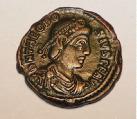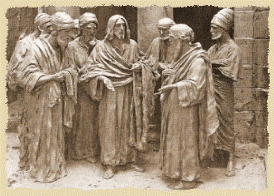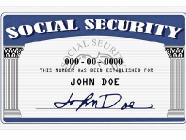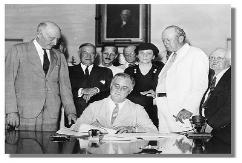 |
||||||
 |
||||||
|
|
||
 |
||||
 |
||||
Some Historical Observations President Franklin D. Roosevelt signed the Social Security Act on August 14, 1935. Taxes for social security were collected for the first time on January 1937. At the time, clergy were not able to be part of the Social Security system. Even so, the President sent a letter to the nation’s clergy soliciting their support among their congregations for this retirement system. Railroad workers and teachers also were not part of the new program. President Roosevelt's Letter to Clergy - Text President Roosevelt's Letter to Clergy - Image
During the 1950s, clergy were able to become part of the program by filing a form to enroll in the Social Security program. In the late 1960s, all clergy were automatically part of the program, but those who had conscientious objections to participating in the program could file a form to exclude themselves and the earnings they received from ministry. During the 1980s, the time for exclusion was limited to two years from the date of ordination. Prior to this change, one could file a form to be excluded at any point during ministry and once filed the exclusion would go into effect for future earnings.
How Are Members of the Clergy Excluded from Paying Social Security Taxes? To exclude oneself IRS Form 4361 needs to be completed and filed. Among other things the form states:
IRS Form 4361 - Social Security Exemption Being excluded from the Social Security system only applies to earnings received for work in ministry. Other income for non-ministerial work is not excluded. Social Security benefits are payable if someone has accumulated 40 quarters of paying into the Social Security system – the equivalent of ten (10) years of payments into the system even if they have filed Form 4361. Congress in the past established a few windows to allow clergy to reenter the program since once Form 4361 is signed and approved it is irrevocable. The last window ended on April 15, 2002. While efforts have been made to create other windows since then for reentry, those efforts have failed. Presently, there is no possibility available to revoke one’s exclusion once Form 4361 has been filed and approved. USA Today Article - Think Twice About Opting Out
The Greek Orthodox Archdiocese and Social Security The Uniform Parish Regulations state that a parish is "To pay the full cost of existing Social Security (FICA/SECA) coverage at the full self-employment rate." Article 17, Section 8, A, 5. This regulation's intent is to defray the full cost of Social Security coverage for a clergyman since this coverage is considered an important component of his remuneration package during his active ministry as well as for retirement. It would further be difficult for a clergyman of the Archdiocese to sign Form 4361 in good conscience and to state that he is "opposed to the acceptance ... of any public insurance" in light of the various benefits he receives at no personal cost to him.
Clergy are Self-Employed for Social Security Tax Purposes Clergy by law are considered self-employed for Social Security purposes. Parishes of the Greek Orthodox Archdiocese of America are required by the Uniform Parish Regulations to pay the 15.3% Self-Employed tax rate to the clergyman serving the parish. The parish cannot pay these taxes in behalf of the clergyman as he is considered Self-Employed for these taxes. These taxes are calculated on Schedule SE when filing yearly income tax forms. The Self-Employed tax rate is comprised of two figures – the Social Security Tax rate of 12.4% and the Medicare Tax rate of 2.9%. For 2017 the maximum income subject to the Social Security tax increased to $127,200. There is no income limit for the Medicare Tax. Whatever amount is given to the clergyman to reimburse him for Social Security/Medicare taxes, that amount of money is taxable income and included in his salary/income figure. Once that occurs, then those payments are also subject to the Self-Employment tax. Clergy receiving pension benefit checks from the Greek Orthodox Archdiocese presently have their entire pension benefit designated by the Archdiocese as Housing Allowance and to the extent used for housing related expenses do not pay taxes on that amount.
Social Security Calculation Below Maximum - 2017
|
||
© 2017 by Fr. Michael T. Kontogiorgis |
||||
